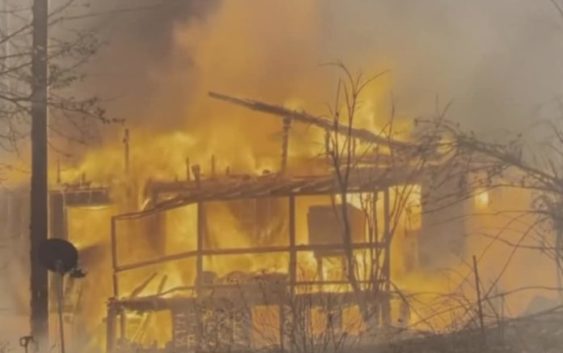- 'She will be greatly missed': Memorial service held for 77-year-old woman killed in SA floods on June 12
- San Antonio officials warn residents to stay vigilant ahead of possible Thursday nights floods
- Flooding is possible in South Texas as we head into July 4th. Here's where.
- Flood Watch issued for counties west of San Antonio | Weather Impact Alert
- Possible heavy downpours and flooding in Hill Country counties | Weather Impact Alert
Wildfire explodes to third-largest in California history

GREENVILLE, CA (AP) — A Northern California wildfire that is now the third-largest in state history had burned for weeks, mostly in remote wildland areas with few people, before it roared through the little mountain community of Greenville, driven by shifting winds and bone-dry vegetation.
Eva Gorman has called the town home for 17 years and said it was love at first sight when she and her husband bought the house where they raised their son.
“We walked up to the front of the house and said ‘Oh wow, this is it,” she said, a place where her grandmother’s dining room chairs and her aunt’s bed from Italy fit just right. “You know when you run across something that fits like an old shoe or glove?”
Now the town is in ashes after hot, dry, gusty weather drove the fire through the Gold Rush-era Sierra Nevada community of about 1,000. The blaze incinerated much of the downtown that included wooden buildings more than a century old.
The winds were expected to calm and change direction heading into the weekend but that good news came too late for Gorman. She was told that her home burned down — but is waiting until she can see it with her own eyes to believe it’s gone.
Before fleeing Greenville, Gorman said she managed to grab some photos off the wall, her favorite jewelry and important documents. She is coming to terms with the reality that much of what was left behind may be irreplaceable.
“There is a photo I keep visualizing in my mind of my son when he was 2, he’s 37,” she said. “And you think ’It’s OK, I have the negatives. And then you think. ‘Oh. No. I don’t have the negatives.’”
The Dixie Fire, named for the road where it started, was still raging on Friday after growing overnight by 110 square miles (285 square kilometers), greater than the size of New York City.
“This is going to be a long firefight,” Capt. Mitch Matlow, spokesperson of the California Department of Forestry and Fire Protection, said.
The fire remained at 35% contained Friday morning and now spans an area of 676 square miles (1,751 square kilometers). No injuries or deaths have been reported but the fire continued to threaten more than 10,000 homes.
Officials have not yet assessed the number of destroyed buildings, but Plumas County Sheriff Todd Johns estimated on Thursday that “well over” 100 homes burned in and near the town.
“My heart is crushed by what has occurred there,” said Johns, a lifelong Greenville resident.
About a two-hour drive south, officials said some 100 homes and other buildings burned in the fast-moving River Fire that broke out Wednesday near Colfax, a town of about 2,000. There was no containment and about 6,000 people were ordered to evacuate in Placer and Nevada counties, state fire officials said.
The three-week-old Dixie Fire was one of 100 active, large fires burning in 14 states, most in the West where historic drought has left lands parched and ripe for ignition.
The fire’s cause was under investigation, but the Pacific Gas & Electric utility has said it may have been sparked when a tree fell on one of the utility’s power lines.
On Thursday, the weather and towering smoke clouds produced by the fire’s intense, erratic winds kept firefighters struggling to put firefighters at shifting hot spots.
“We’re seeing truly frightening fire behavior,” said Chris Carlton, supervisor for Plumas National Forest. “We really are in uncharted territory.”
Heat waves and historic drought tied to climate change have made wildfires harder to fight in the American West. Scientists say climate change has made the region much warmer and drier in the past 30 years and will continue to make weather more extreme and wildfires more frequent and destructive.
The blaze hit Greenville from two angles and firefighters already were in the town trying to save it but first they had to risk their lives to save people who had refused to evacuate by loading people into cars to get them out, fire officials said.
“We have firefighters that are getting guns pulled out on them, because people don’t want to evacuate,” said Jake Cagle, an incident management operations section chief.
The flames also reached the town of Chester, northwest of Greenville, but crews managed to protect homes and businesses there, with only minor damage to one or two buildings, officials said.
The fire was not far from the town of Paradise, which was largely destroyed in a 2018 wildfire sparked by PG&E equipment that killed 85 people, making it the nation’s deadliest U.S. wildfire in at least a century.
Gorman said she asks herself how another California town could be reduced to ashes.
“That’s what I keep thinking. It’s happening, again,” said Gorman. “It’s unfathomable.”
___
Nguyen reported from Oakland, California. Associated Press writers Christopher Weber and Stefanie Dazio in Los Angeles and Jocelyn Gecker in San Francisco contributed to this report.